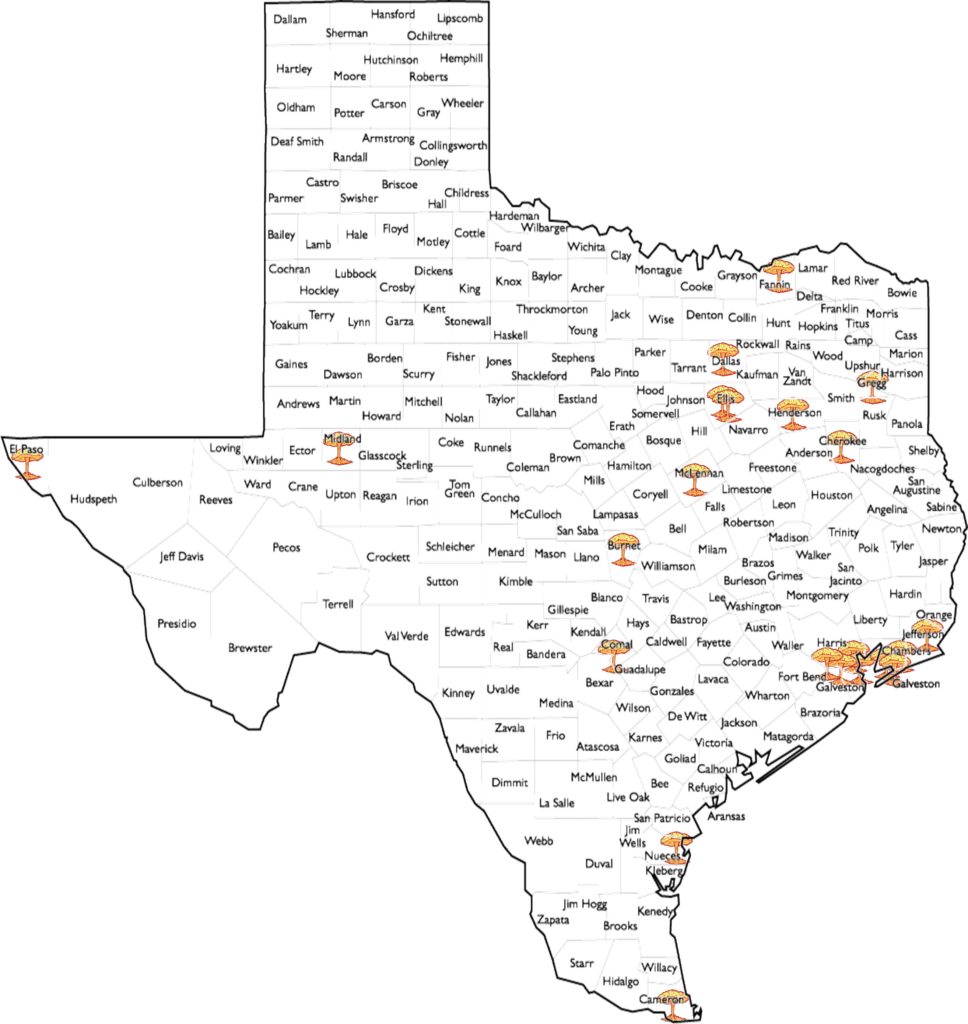Knowing whether to run or hide is a fundamental survival mechanism that Texans living near chemical plants and refineries know too well.
But it can be impossible to make the right decision without accurate and timely information. Is it safe to go outside? Is it safe to “shelter in place” in the nearest building? Is evacuation the only safe option?
The Legislature is holding a public hearing in the House Environmental Regulation Committee on a proposed law to help Texans get the critical information they need when toxic chemicals are released into our air and water. The hearing is in the Texas Capitol Extension Room, E1.026 on Tuesday, March 28th at 8:00 AM
Urge the Legislature to move forward on the Toxic Chemical Emergency Alert System.
Ask the House Environmental Regulation Committee to support HB 1927.
The legislation, HB 1927, would establish a system to alert neighboring communities when a facility releases toxic chemicals.
People in the affected area would get notices on their phones about the chemicals released, what direction they are moving and how to stay safe.
 The Toxic Alert Bill directs the State Emergency Response Commission to develop a statewide system to inform the public of chemical emergencies in a timely manner using a multi-media
The Toxic Alert Bill directs the State Emergency Response Commission to develop a statewide system to inform the public of chemical emergencies in a timely manner using a multi-media
approach, including traditional media, social media, and wireless emergency alerts.
This statewide system will eliminate patchwork local approaches and relieve local governments of the burden of developing and maintaining their own systems. Residents will be directed to a hyperlink, which will provide:
- The geographic area impacted by the release
- Information on symptoms that could require emergency medical treatment,
- Directionality of plume movement,
- The chemicals involved in and toxicity of the release,
and - Instructions for protection from exposure to the release.
Just like the Amber Alerts for missing persons and emergency weather alerts available on our phones, the Toxic Chemical Emergency Alert System should be available to keep our communities safe.
A recent poll of Houston area residents shows that most people are concerned about air pollution and its impact on vulnerable populations. Furthermore, 92% support the creation of a public notification system similar to Amber alerts for leaks of hazardous chemicals. These alerts would warn residents via cellular phone of incidents and let them know what action to take to keep safe.
According to an investigative report published by the Houston Chronicle in 2016, an incident involving hazardous materials in the Houston area occurs about every six weeks. Nationally, there have been more than 93 incidents involving hazardous chemicals since late 2015, killing 7 and injuring 573 people.
As you can see from the list and map below, the folks in the Houston area are more aware of the issue because of the frequency of such events, but you can see that other parts of the state also experience these types of toxic emergencies.
- Oct. 2011: Massive chemical fire at Magnablend facility, Waxahachie. Schoolchildren and neighbors evacuated.
- Nov. 2012: Massive explosion & chemical fire at Nexeo chemical plant, Garland. Local area evacuated.
- Apr. 2013: Chemical fire at East Texas Ag Supply, Athens. Hundreds of people evacuated.
- May. 2014: Massive explosion & chemical fire at West Fertilizer, Co., West. Fifteen people dead and 160 injured.
- Jan. 2015: Chlorine Spill at Magnablend facility, Waxahachie. Employees and neighbors evacuated.
- Apr. 2015: Train derailment carrying flammable chemicals, Longview. Neighbors evacuated.
- Aug. 2015: Massive fire at Century Industrial Coatings, Jacksonville. A neighboring business evacuated.
- Jan. 2016: Explosion and fire at water treatment plant, Midland. One person dead, local residents evacuated.
- Jan. 2016: Explosion at PeroxyChem, Pasadena. One person dead, three others injured.
- Mar. 2016: Explosion at Pasadena Refining Systems, Inc., Pasadena. One person burned.
- Apr. 2016: Explosion at LyondellBasell, SE Houston. Shelter in-place in SE Houston, including Chavez H.S., Deady Middle School, and Rucker Elementary School.
- May 2016: Fire and chemical release in Spring Branch. Shelter-in-place. Fish, turtles, snakes, and frogs die from chemical spill.
- Jun. 2016: Chemical leak & fire, Mont Belvieu. Dozens of people evacuated from their homes.
- Jul. 2016: Asphalt fire, Century Asphalt Plant, Burnet. Dozens of residents evacuated.
- Jul. 2016: Propylene leak, ExxonMobil Pipeline, Baytown. Local evacuation and shelter-in-place for nearby community.
- Jul. 2016: Chemical Release at Pasadena Refining Systems, Inc., Pasadena. Heavy black smoke and sulfur dioxide release, shelter-in-place for Galena Park residents.
- Aug. 2016: Explosion at Voluntary Purchasing Group, Bonham, woke up neighbors. A second explosion one month later injured 2 workers.
- Aug. 2016: Fire at Hexion in Deer Park, shelter-in-place for neighborhoods in Deer Park.
- Sept 2016: Chemical spill in Willow Marsh Bayou, Beaumont. Local shelter-in-place, killed over 1,400 fish, snakes, turtles, racoons, and birds.
- Dec. 2016: A chemical leak contaminated the drinking water supply for Corpus Christi. A water ban was in effect for nearly 4 days, 7 unconfirmed illnesses associated with the drinking water.
- Jan. 2017: Naphtha overfill at tank at Valero Texas City Refinery. Residents issues. No shelter in place alert was sent because “the incident happened in the middle of the night.”
- Jan. 2017: Chemical fire and spill, El Paso. Residents complain to TCEQ amidst concerns of respiratory issues.
- Mar 2017: Sodium hydrosulfide spill, Brownsville. One injured, evacuation downtown.
In 2014, Iowa implement the Alert Iowa System. Counties that did not already have a system like this in place could opt-in to the statewide system to ensure that Iowans are protected from severe weather, chemical spill, and other potential disasters. The statewide system in Iowa costs about $300,000 per year.
Texas already has a system in place that can send out these type of alerts. The system proposed here is designed to work with OEMs to support them based on their needs. The intention is not for the statewide system to override functional systems already in place.
If such a system saved lives or reduced job and school absenteeism as a result of exposure to toxic chemicals, it would be well worth the cost of extending our existing technology to put in place a toxic chemical emergency system. Urge your Legislator to move forward on the Toxic Chemical Emergency Alert System.



